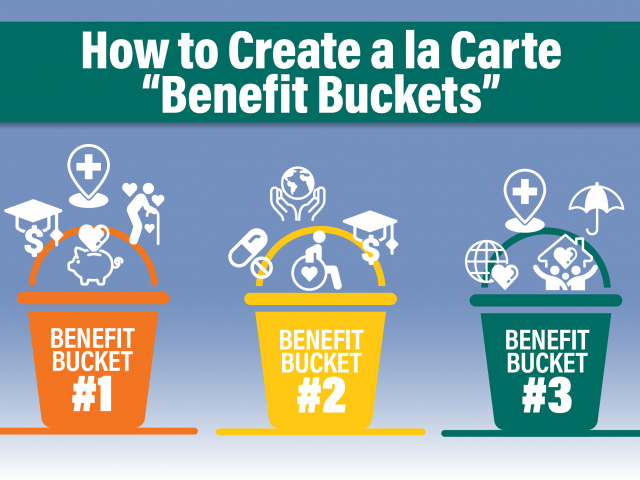 How to Create A la Carte “Benefit Buckets”
How to Create A la Carte “Benefit Buckets”
By Allison Madison
Traditionally employers like to keep things straightforward and offer all their employees the same package of benefits. It’s done with the best intentions, but in light of the current labor shortage, it’s actually an unfair policy that doesn’t recognize the diversity and humanity of the evolving workforce. Employees are diverse in age, culture, finances, marital status, lifestyles, health, and interests. The traditional method of treating everyone exactly the same, doesn’t respond to the fact that one size does not fit all! People value different things at different stages of their careers, and they have ever-changing circumstances. For example; the wants and needs of a recent college graduate with large school loans to pay off is very different from a colleague with three children under 5 who desperately needs childcare. With all sectors struggling to fill positions, we think it’s time for employers to acknowledge the changing workforce, get creative, and design multiple “benefit buckets” that have predetermined monetary value. Let candidates and employees pick and choose—a la carte—the benefits that are most meaningful to them. Here’s how to get started.
- Brainstorm benefit ideas. Let your imagination go wild and make a list of anything and everything you think people want and need—Healthcare (medical, dental, vision), retirement, flex time, childcare, paid and unpaid vacation time, paid holidays, paid family or medical Leave, transportation stipend, wellness programs, meal plans, tuition reimbursement, professional development opportunities, life insurance, disability, long-term care plans, life insurance plans, pension plans, technology, bonuses, and more. There are a vast array of options that could appeal to your workforce. Brainstorm with your leadership team to determine the viable options for your organization.
- Organize benefits by varying life milestones and circumstances: We have to imagine the different types of people we have working for us and the scenarios they encounter in their lives that make certain benefits more valuable or expendable. For example, health insurance. Health insurance is one of the costliest benefits to provide to employees and we might assume that everyone wants and needs coverage. But consider the employee who is married and covered under their spouse’s plan. Someone already covered is not going to value health coverage and might choose to make up that difference with extra paid vacation time, or family leave.
- Assign a value to each benefit: Once the leadership team determines the list of benefits they are interested in providing, meet with the experts and the finance department to assign a value to each benefit grouping.
- Determine the maximum budget: Every organization is different and should consider what benefits they can afford to provide over and above a market wage. Remember that the advertised salary should be commensurate with what your competitors offer to attract candidates.
- Organize Your Benefit Buckets: Once you have your benefit budget decided, determine the value of each “bucket” and assign the a la carte benefits to each one. To keep things manageable start with 3 buckets to address the average types of employee— single, married couple, family—and build from there.
- Create an employee advisory committee: Once the a la carte benefits chart is created and reviewed by legal and finance experts, test drive it with a group of employees that represent a diverse group to get feedback. Revise the buckets accordingly.
Salary transparency laws have leveled the playing field as far as compensation goes but there is still plenty of room to get creative with how you package benefits. If you take action on implementing the a la carte “benefits bucket” your organization will definitely stand out. Lead on!


